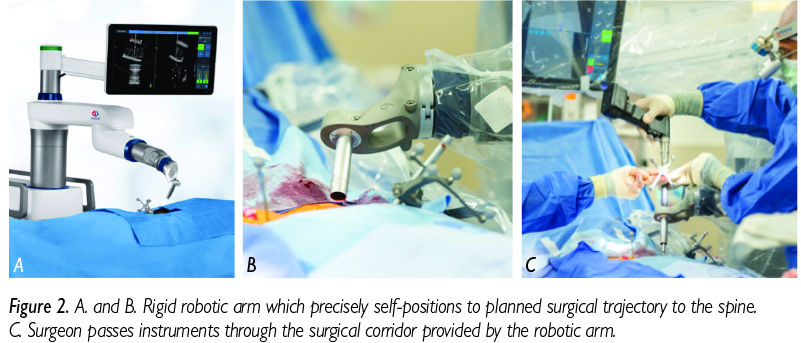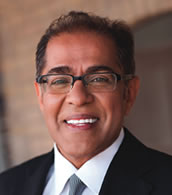Robotic Spine Surgery: Tomorrow’s Technology Today at OakLeaf Surgical Hospital
Kamal Thapar, MD, PhD, FRCSC, FAANS
Neurosurgery & Spine Surgery
Wisconsin Brain & Spine Center
Altoona
Surgical robotic systems have revolutionized modern medicine, allowing surgeons to care for patients with greater precision, safety, and effectiveness. One of the most recent innovations has been the application of robotics to spine surgery, allowing surgeons to perform reconstructive spine surgeries though small precise incisions, minimizing tissue trauma, reducing blood loss and other complications, all of which may lead to faster patient recovery. OakLeaf’s new Globus ExcelsiusGPS robotic system further elevates our existing minimally invasive approaches to spine surgery to a truly new frontier of surgical precision and safety.
Robotic spine surgery versus traditional spinal surgery
 All too often, patients are understandably fearful of spine surgery, as the mere mention of this option conjures distressing images of big incisions, prolonged hospitalization, immobility, and slow painful recoveries. As the spine is located deep within the body, traditional spine surgery involves large incisions, disruption of muscles, and damage to delicate ligaments and other stabilizing structures, all being stripped aside in order to expose and correct a diseased spine. The surgical robot uses a global positioning system that creates a real time three dimensional map of a patient’s individual anatomy (Figure 1), allowing the surgeon to precisely plan and navigate to the spine through tiny incisions without disrupting supporting tissues that envelop the spine. The navigational system allows the surgeon to “see” the anatomy without having to actually expose it surgically, and the robotic arm provides the surgeon a safe and optimized surgical corridor through which implants for spinal reconstruction can be deployed (Figure 2). The result is less tissue injury, reduced risk of injuring delicate neural structures, less post operative pain, less scarring, less blood loss, fewer complications,
less radiation exposure to the patient, a shorter hospital stay, and a faster recovery.
All too often, patients are understandably fearful of spine surgery, as the mere mention of this option conjures distressing images of big incisions, prolonged hospitalization, immobility, and slow painful recoveries. As the spine is located deep within the body, traditional spine surgery involves large incisions, disruption of muscles, and damage to delicate ligaments and other stabilizing structures, all being stripped aside in order to expose and correct a diseased spine. The surgical robot uses a global positioning system that creates a real time three dimensional map of a patient’s individual anatomy (Figure 1), allowing the surgeon to precisely plan and navigate to the spine through tiny incisions without disrupting supporting tissues that envelop the spine. The navigational system allows the surgeon to “see” the anatomy without having to actually expose it surgically, and the robotic arm provides the surgeon a safe and optimized surgical corridor through which implants for spinal reconstruction can be deployed (Figure 2). The result is less tissue injury, reduced risk of injuring delicate neural structures, less post operative pain, less scarring, less blood loss, fewer complications,
less radiation exposure to the patient, a shorter hospital stay, and a faster recovery.

Who is a candidate for robotic spine surgery?
Whereas robotic spine surgery changes how we do surgery by making it safer and more precise, it doesn’t change our indications for who should have spine surgery. Spinal problems are common and present with symptoms such as neck and back pain. Nerve compression can cause pain, numbness, and weakness in the arms and legs. For the vast majority of patients, these symptoms are effectively treated by nonsurgical means such as physiotherapy, chiropractic care, anti-inflammatory medications, and sometimes spinal injections (“pain shots”). In a minority of patients, however, these therapies will prove ineffective, and spine surgery needs to be considered. In general, surgical candidates will have severe compression of spinal  nerve roots (spinal stenosis), deformity of the spine (e.g. scoliosis), or instability of the spine (e.g. spondylolisthesis). In many instances such as spinal stenosis, the compressed nerves require only simple, minimal access decompression to restore the normal caliber of the spinal canal, relieve pressure, and restore function. In more complex situations, spinal decompression needs to be accompanied by fusion of two or more vertebrae for restoration of stability and/or correction of deformity, and requires the placement of screws, rods, and other spinal implants (Figure 3). It is for these latter patients that the surgical robot will provide the greatest benefit. As robotic technology continues to evolve, it is likely that an even broader spectrum of spine surgery patients may eventually accrue benefit for robotic-assisted surgery.
At present, however, we use the robot only for those patients requiring spinal fusion.
nerve roots (spinal stenosis), deformity of the spine (e.g. scoliosis), or instability of the spine (e.g. spondylolisthesis). In many instances such as spinal stenosis, the compressed nerves require only simple, minimal access decompression to restore the normal caliber of the spinal canal, relieve pressure, and restore function. In more complex situations, spinal decompression needs to be accompanied by fusion of two or more vertebrae for restoration of stability and/or correction of deformity, and requires the placement of screws, rods, and other spinal implants (Figure 3). It is for these latter patients that the surgical robot will provide the greatest benefit. As robotic technology continues to evolve, it is likely that an even broader spectrum of spine surgery patients may eventually accrue benefit for robotic-assisted surgery.
At present, however, we use the robot only for those patients requiring spinal fusion.
What is today’s “cutting edge” often becomes tomorrow’s standard of care. This may prove especially true for robotic spine surgery where the benefits are many and the drawbacks are few. By introducing this technology to Western Wisconsin, our neurosurgical team now expands the repertoire of robotic surgeries already being performed at OakLeaf Surgical Hospital, complementing the robotic joint replacement program that has enjoyed great success over recent years.
Kamal Thapar, MD, PhD, FRCSC, FAANS – Wisconsin Brain & Spine Center
For information or to schedule an appointment:
715-832-1700 | 800-322-1747 | www.oakleafmedical.com
Dr. Thapar sees patients in Altoona, Cumberland, Black River Falls, Rice Lake, Hudson and Chippewa Falls.



 All too often, patients are understandably fearful of spine surgery, as the mere mention of this option conjures distressing images of big incisions, prolonged hospitalization, immobility, and slow painful recoveries. As the spine is located deep within the body, traditional spine surgery involves large incisions, disruption of muscles, and damage to delicate ligaments and other stabilizing structures, all being stripped aside in order to expose and correct a diseased spine. The surgical robot uses a global positioning system that creates a real time three dimensional map of a patient’s individual anatomy (Figure 1), allowing the surgeon to precisely plan and navigate to the spine through tiny incisions without disrupting supporting tissues that envelop the spine. The navigational system allows the surgeon to “see” the anatomy without having to actually expose it surgically, and the robotic arm provides the surgeon a safe and optimized surgical corridor through which implants for spinal reconstruction can be deployed (Figure 2). The result is less tissue injury, reduced risk of injuring delicate neural structures, less post operative pain, less scarring, less blood loss, fewer complications,
less radiation exposure to the patient, a shorter hospital stay, and a faster recovery.
All too often, patients are understandably fearful of spine surgery, as the mere mention of this option conjures distressing images of big incisions, prolonged hospitalization, immobility, and slow painful recoveries. As the spine is located deep within the body, traditional spine surgery involves large incisions, disruption of muscles, and damage to delicate ligaments and other stabilizing structures, all being stripped aside in order to expose and correct a diseased spine. The surgical robot uses a global positioning system that creates a real time three dimensional map of a patient’s individual anatomy (Figure 1), allowing the surgeon to precisely plan and navigate to the spine through tiny incisions without disrupting supporting tissues that envelop the spine. The navigational system allows the surgeon to “see” the anatomy without having to actually expose it surgically, and the robotic arm provides the surgeon a safe and optimized surgical corridor through which implants for spinal reconstruction can be deployed (Figure 2). The result is less tissue injury, reduced risk of injuring delicate neural structures, less post operative pain, less scarring, less blood loss, fewer complications,
less radiation exposure to the patient, a shorter hospital stay, and a faster recovery.
 nerve roots (spinal stenosis), deformity of the spine (e.g. scoliosis), or instability of the spine (e.g. spondylolisthesis). In many instances such as spinal stenosis, the compressed nerves require only simple, minimal access decompression to restore the normal caliber of the spinal canal, relieve pressure, and restore function. In more complex situations, spinal decompression needs to be accompanied by fusion of two or more vertebrae for restoration of stability and/or correction of deformity, and requires the placement of screws, rods, and other spinal implants (Figure 3). It is for these latter patients that the surgical robot will provide the greatest benefit. As robotic technology continues to evolve, it is likely that an even broader spectrum of spine surgery patients may eventually accrue benefit for robotic-assisted surgery.
At present, however, we use the robot only for those patients requiring spinal fusion.
nerve roots (spinal stenosis), deformity of the spine (e.g. scoliosis), or instability of the spine (e.g. spondylolisthesis). In many instances such as spinal stenosis, the compressed nerves require only simple, minimal access decompression to restore the normal caliber of the spinal canal, relieve pressure, and restore function. In more complex situations, spinal decompression needs to be accompanied by fusion of two or more vertebrae for restoration of stability and/or correction of deformity, and requires the placement of screws, rods, and other spinal implants (Figure 3). It is for these latter patients that the surgical robot will provide the greatest benefit. As robotic technology continues to evolve, it is likely that an even broader spectrum of spine surgery patients may eventually accrue benefit for robotic-assisted surgery.
At present, however, we use the robot only for those patients requiring spinal fusion.